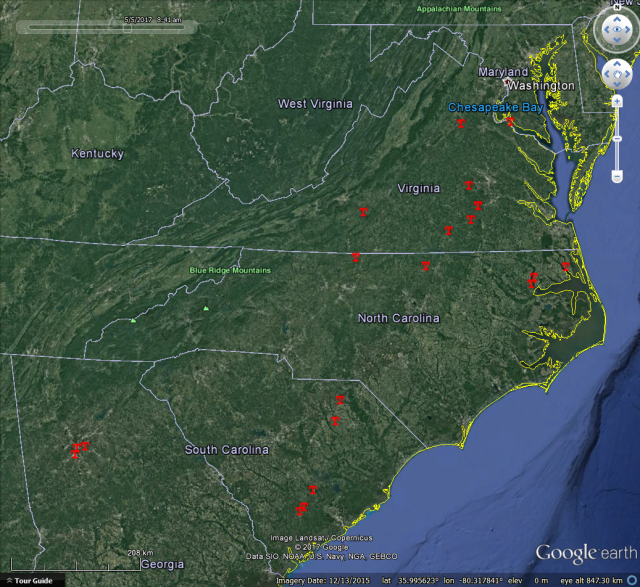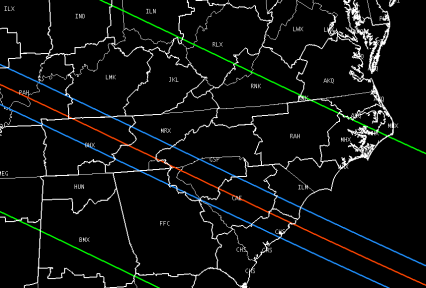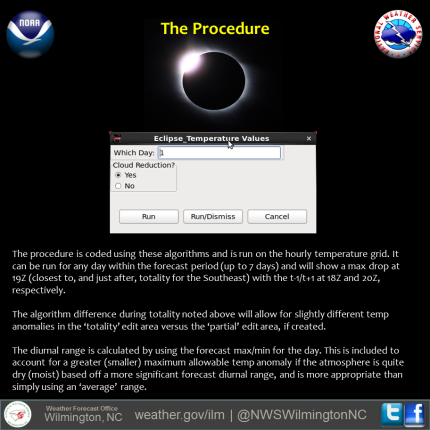A total solar eclipse is a rare event. In the past 50 years, there has been only 1 total eclipse visible from the Southeast United States, on March 7, 1970, and just a handful of partial eclipses including May 30, 1984 which was a nearly total annular eclipse. Although these events are rare, many phenomena associated with them, including birds roosting, crickets chirping, stars and planets becoming visible, and even the elusive shadow bands, are well documented. For these reasons, the total solar eclipse on August 21, 2017 was a highly anticipated event across the entire continental United States.
This total solar eclipse was also exciting for the meteorological community. It is well known that temperatures cool during, and just after, a total solar eclipse, but the amount of cooling is quite uncertain. Leading up to the eclipse, examples of cooling from total solar eclipses in Zambia in 2001, and South Carolina in 1900, were referenced as possible analogs to what could be expected in 2017. The Zambia case was most widely distributed due to the observations of 15 degrees of cooling during that event, which led to extremely high forecasts of potential temperature drops of up to 20 degrees being predicted across social media and news outlets leading up to the 2017 event.

Temperature curve from the 2001 total eclipse in Zambia. (https://eclipse2017.nasa.gov/temperature-change-during-totality)
The truth is that while some cooling was nearly certain, the amount of temperature drop was unknown. The National Weather Service (NWS) creates hourly temperature forecasts out through a 7 day forecast period twice a day, every day of the year, and in order to create an accurate forecast for the day of the eclipse, NWS offices would need to add some amount of cooling during the afternoon of August 21 to their hourly temperature forecasts. With such a high profile event, consistency and accuracy among NWS Weather Forecast Offices (WFO) was very important.
Realizing the need for a consistent prediction of temperature cooling during the eclipse, Josh Weiss from NWS Wilmington, NC developed an algorithm to reduce hourly temperatures based off data from the 1970 total and 1984 annular eclipses. METARs from 15 regional ASOS stations during the two eclipses were examined to analyze the temperature curves, cloud cover, and the solar obscuration percentage within a few hours of maximum eclipse. While this gave a nice picture of the hourly drop in temperature at each station, it didn’t truly solve the problem of the total drop from the typical diurnal temperature curve which is more important than the cooling from hour-to-hour. The NWS forecasts a diurnal curve in the hourly forecast, so determining the difference between the “expected” diurnal temperature and the actual temperature was the important parameter to determine.
Knowing this, a typical diurnal curve was then calculated for each station utilizing METAR data from the same calendar day from 6 prior years within the normal climate period (1981-2010), similar to the analysis done during the 1900 eclipse. From these curves, the difference between the realized temperature during maximum eclipse, and the expected temperature at that time on a typical diurnal day was calculated, and called diurnal drop. This was calculated for h(0) (hour closest to maximum eclipse) as well as h-1 and h+1.

Temperature curves during the 1900 Total Solar Eclipse. Taken from 1902 U.S. Weather Bureau Report (https://www.ncei.noaa.gov/news/1900-total-solar-eclipse)
After completing this analysis, it was discovered that peak cooling occurred shortly after maximum eclipse, but that cloud cover played a much stronger role in determining diurnal drop than did solar obscuration. However, the variety of values was still not enough to determine if this was an accurate analysis of diurnal drop without some baseline value.
To solve this problem, the results of the analysis were compared to the NASA theory that states: The maximum temperature drop during a total solar eclipse can range from between ½ and ¾ the average diurnal range for the day (https://eclipse2017.nasa.gov/faq).
It is likely that the ¾ range would be for longer eclipses (a total solar eclipse can last up to 7 minutes) so with totality during the August 21 eclipse only lasting 2-3 minutes, the ½ value was used as a proxy for maximum potential drop during the event. This approach is quite helpful because utilizing this range will factor in time of year and humidity since the typical diurnal range in the Southeast during humid summer months can be smaller than during the cool and dry fall/winter months.
Putting all this together, an algorithm was developed to calculate expected maximum diurnal drop. The calculation included all the data from the previous eclipses, but also factored in a subtle difference for locations that would experience totality versus those that would not. This was included thanks to input from Frank Alsheimer at WFO CAE who provided guidance on local climatology and data from past eclipse events across Europe.
Maximum diurnal drop equation for solar obscuration = 100% at h(0):
If Sky Cover ≤ 50%:
Diurnal drop = 0.74 * ( ½ diurnal range)
If Sky Cover > 50% and Sky Cover ≤ 87%:
Diurnal drop = 0.64 * ( ½ diurnal range)
If Sky Cover > 87%:
Diurnal drop = 0.54 * ( ½ diurnal range)
For solar obscuration ≥ 90% but < 100% at h(0), the coefficients were reduced to 0.69, 0.59, and 0.49, respectively. A similar equation was developed for the h-1 and h+1 temperature changes, but the data was much more variable so that equation is not included here and instead saved for a more in depth study.
These calculations were then incorporated into a GFE smartTool and Procedure to provide the most scientifically sound and consistent method to adjust the hourly temperature forecasts. The tool would adjust the initial hourly temperature forecast during the period of the eclipse (17Z-20Z) with an eclipse based adjustment that includes forecast cloud cover and the percent of solar obscuration.

GFE SmartTool interface used by forecasters
Once testing was completed, WFO ILM shared the GFE smartTool and Procedure with all the southeast WFOs hoping to create the most consistent and accurate forecast possible. Of these, 5 WFOs incorporated the tools into their GFE to create forecasts during the week leading up to the eclipse. Additionally, shapefiles of eclipse information were developed for use in some applications, GIS maps detailing eclipse obscuration percentages were installed in AWIPS, and methodologies and strategies were shared amongst the Southeast WFOs via a Google document.

Map of the percentage of sun obscuration during the eclipse shown in AWIPS. The green lines are 90% or greater, the blue lines represent the path of totality, or 100%, and the red is the center line, or max totality.
The effort did not go unnoticed. Social media and news outlets began to note the forecast cooling created in both the NWS hourly weather graph as well as NDFD grid images as early as August 17th. The interest continued to ramp up through August 21st, with numerous posts made about NWS temperatures during the eclipse across all social media platforms.

Having a sound methodology among WFOs proved extremely beneficial, and with potentially millions of people heading to the Southeast for the eclipse it was crucial to have a consistent message from the local WFOs. This effort built on the history and relationships already in place across the CIMMSE domain, and is a great example of many NWS meteorologists and WFOs working together to provide enhanced forecasts and service.
The weather pattern during the afternoon of August 21, 2017 featured an elongated ridge of high pressure aloft extending from the sub-tropical Atlantic westward across the Southeast into the Mississippi Valley. A ridge of surface high pressure extended from off the Mid-Atlantic coast westward into the southern Appalachians. To the south, a decaying stationary surface boundary extended east to west from just off the North Carolina coast westward to the South Carolina coast and into southern Georgia. The air mass across the Southeast was generally weakly unstable although an axis of moderate instability, with mixed-layer CAPE values of 1500 J/Kg or more extended in an arc near the surface boundary west and northwest across the western Carolinas into the southern Appalachians.
Regions of enhanced cloudiness along with scattered convection developed during the early and mid-afternoon hours near and just off of the North Carolina coast and across much of coastal South Carolina in a region of greater moisture and instability and convergence near the surface boundary. More scattered cloudiness and isolated convection was noted across the remainder of South Carolina, western North Carolina, and especially across the higher terrain of the southern Appalachians. This cloudiness was associated with a weak shear axis aloft and enhanced by differential heating in the mountains. Elsewhere across the Southeast, skies were generally partly to mostly clear.

GOES-16 Channel 2 visible satellite imagery at 1822Z, just prior to totality in the Carolinas. Note the enhanced cumulus along the Appalachians, widespread cloud cover along the GA/SC/NC coasts, as well as the very dark area across TN/KY/MO which is beneath the totality shadow.

Regional radar mosaic at 1848Z, during totality across SC. Rain and thunderstorms heavily impacted viewing along the coast as well as in a few locations in NC.
A forecast is only as good as its verification, and an after-event analysis was completed on 16 Southeast ASOS sites. The verification consisted of analyzing 1 minute temperature data for each site from NCDC and comparing the drop to the expected temperature value at that time. Data was acquired here:
(ftp://ftp.ncdc.noaa.gov/pub/data/asos-onemin/6406-2017)
To compare the algorithm performance to observations, METARs were examined for each of the 16 sites to acquire the max and min temperature for the day, as well as cloud cover during the eclipse, since this was not available in the minute data from NCDC. The algorithm was then applied to each site using the max/min as a proxy for the “expected” diurnal range and cloud cover, to produce the “forecast” diurnal drop. This value is what the algorithm would have given had the forecast of temperature and sky cover been correct; a perfect hindcast. Using this value as the forecast diurnal drop and comparing to the observed drop, provided the comparison for tool verification.
Of the 16 sites analyzed, 4 (CRE, CHS, GSO, INT) had to be removed due to precipitation or nearby convection and outflow affecting the temperature during the hours of the eclipse. Of the other 12, 5 had a perfect (0 degree error) forecast of diurnal drop, while 11 in total, or 92%, had measured diurnal drops within 2 degrees of the algorithm forecast. The last location (CAE) showed an error of just 3 degrees, just outside the acceptable “correct” forecast range.

Results from the analysis. Locations in red were removed due to weather.
Verification so far has been excellent, but further work is needed. Analysis of all Southeast ASOS where solar obscuration was 90% or greater will be completed to further refine the results and ensure the accuracy of the algorithm. Once this is completed, it will be important to delve into the missed cases (error > 2 degrees) to try to determine why this occurred. Obtaining 1 minute cloud cover, if available, would supplement this study well.
Additionally, this algorithm was not the only one used to forecast temperature cooling across the country during the eclipse, and comparison to some of the other tools would be an interesting addition to this research. Perhaps a more nationally consistent methodology can be derived from this extended investigation, such that high confidence in diurnal cooling can be applied to hourly temperature curves during the 2024 total solar eclipse.
Many thanks to Jonathan Blaes at WFO RAH for his support and additions to this blog entry, and to Donald Hawkins at WFO ILM for a thorough and helpful review before publishing.





































